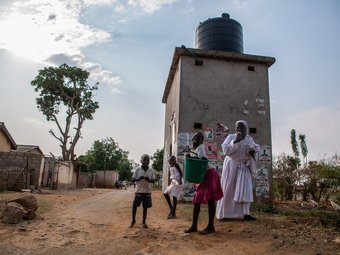Categories
Zimbabwe
Key facts
Hazards covered by anticipation
Anticipation partners in country
Start Network | WFP | FAO | Zimbabwe Red Cross Society | Danish Red Cross | Finnish Red Cross | 510 initiative of the Netherlands Red Cross | Red Cross Red Crescent Climate Centre | Meteorological Services Department | Department of Civil Protection | Ministry of Agriculture | Welthungerhilfe
Inform Risk Index (2022)
Hazard and exposure: 3.7
Vulnerability: 6.1
Lack of coping capacity: 5.9
Total: 5.1 (high)
Rank: 41
Photo: Hugo Nijentap / IFRC
Country profile
Zimbabwe is a low-income country with a subtropical climate. The economy and people’s livelihoods are closely linked to the agricultural sector, which accounts for 67 per cent of total employment. Approximately 80 per cent of agricultural production is rain-fed, and Zimbabwe is one of the most irrigation-dependent countries in southern Africa. In recent years, the country has also faced an economic crisis marked by high inflation, which has been compounded by the effects of COVID-19 on exports, tourism and manufacturing.
Zimbabwe is particularly prone to drought, floods and wildfires. Of these, floods and droughts, as well as cyclones, adversely affect food security and increase the likelihood of disease and pest outbreaks. Under a changing climate, rainfall patterns and seasons are expected to become more variable and erratic, which will make the largely rain-fed agricultural sector even more vulnerable.
Drought is the most common hazard, affecting the highest number of people and occurring most frequently in southern and western Zimbabwe. Drought has serious consequences in terms of water availability for the agricultural sector, as well as for domestic consumption and generating industrial power. As it affects crop production, drought also contributes to food security. Economic losses and other impacts of drought tend to last longer and be greater than those of other hazards.
Floods occur most frequently in low-lying areas, particularly in southern and northern Zimbabwe. They are often associated with cyclone paths. Storms that cause flooding, hail or strong winds also damage infrastructure, housing and crops, and can cause the loss of life and livestock.
Zimbabwe activated its Early Action Protocol for Drought in September 2023.
Projects
Development of forecast-based action mechanisms addressing drought-induced food insecurity in Zimbabwe
In 2020, Welthungerhilfe launched a project to develop predictive humanitarian aid mechanisms for food security in the event of drought in Zimbabwe. The Early Action Protocols (EAPs) created as part of the project reduce the risks to the food security of vulnerable communities, prevent negative management strategies, and minimize the loss and damage suffered by drought-affected households.
Forecast-based actions in Zimbabwe
Since 2019, the Zimbabwe Red Cross Society has been developing an EAP for drought, with support from the Danish Red Cross, the Finnish Red Cross and the Climate Centre.
Forecast-based financing in Zimbabwe
Since 2019, WFP has been working with the Zimbabwe Red Cross Society and the government of Zimbabwe to establish a forecast-based financing system for drought.
FAO is supporting early actions for drought and COVID-19 in Zimbabwe.
Further resources
- How P-FIM adds value to developing protocols for anticipatory action
- Community-driven early action protocols: how P-FIM is unlocking locally led anticipatory action in Zimbabwe
- Early Action Protocol activation: Zimbabwe - Drought
- Early Action Protocol summary: Zimbabwe - Drought
- Forecasting Drought in Zimbabwe: Advances, Challenges, and Future Opportunities



